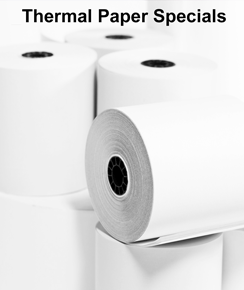Can Receipts be Recycled?
Would you imagine stepping inside a shop, buying something, and not getting your receipt? We hope not! Receipts have become an important part of our everyday lives. Every time you make a transaction, receipts function as proof of purchase.
When you purchase something, your receipt shows where you bought it and how much money was paid. The receipt is generated by the company that sells it and gives you all this information easily. Most companies automatically give you a copy of the receipt and some print one on-demand after the sale (so make sure to ask!). This is also used as evidence if there's any dispute about what happened with your purchase.
But what are receipts made of and can they be recycled? All sustainable companies and consumers are ardently looking for answers.
The answer is slightly complicated, it depends. Basically, whether or not receipts can be recycled depends on their composition. Receipts are usually made from thermal paper which is largely unrecyclable. Thermal paper receipts contain chemicals that react with heat to produce imprints.
While recycling thermal paper remains a debatable issue, there are several ways that we can help reduce waste by reusing these materials. In this article, we will discuss the different types of paper used in receipts and how you can recycle them.
Recycling Paper: Different Types of Receipt Paper
There are three main types of paper commonly used in receipts. They include thermal paper, copy paper, and carbonless paper. Below, we explore each type of receipt paper in detail.
Please note that this is only a general description of each type of paper and does not cover all possible variations. Top brands and retailers around the globe now offer a host of different varieties of each type of paper which can be used for different purposes. However, thermal paper, to date, remains the most common type of paper used for receipts.
- Thermal Paper
There are many reasons why the thermal paper is dominating the receipt paper industry across different sectors like finance, retail, and e-commerce which have wholeheartedly embraced thermal paper receipts. The biggest drivers of demand for thermal paper receipts are their convenience, ease of use, and low maintenance cost as they do not require expensive cartridges or inks for printing. It is, in fact, perfect for thermal printers, cash registers, and credit card terminals.
So how does thermal paper work? Thermal papers are coated with chemicals on one side which, on the contact of heat, react and produce black imprints. The side of the thermal paper which is coated is usually identifiable owing to its brightness and smoothness.
- Bond Paper
There are high chances that you must have come across the bond paper (or plotter paper) while perusing paper catalogs. Bond paper is a high-quality, writing paper consisting largely of cotton rag fiber. It’s called bond paper because it was traditionally used for government bonds.
There is a wide variety of bond paper available for a host of different uses. Bond paper is strong, durable, and high quality which is why you may find it being used for official business, memos, flyers, announcements, brochures, and postings. It is suitable for printing and is used in office machines.
- Carbonless paper
Carbonless paper, as the name suggests, is paper that has eliminated the need for carbon between papers to produce copies. Before carbonless paper was introduced, carbon paper was necessary to create copies of receipts for consumers and businesses. Between the receipt paper and another paper, the pressure from writing on carbon paper would create an imprint on the bottom paper.
While this process certainly helped in creating copies, it was inconvenient and messy. Carbon paper can soil your hands and other things on contact. Secondly, whatever you write on carbon paper would remain on it which made it a tool for breach of privacy whenever users decided to discard it.
Choosing the right receipt paper for your business
With different varieties of receipt papers available, it can be difficult to pick the ones that suit your business needs the best. Lucky for you, here we explore all the differences and similarities between the three kinds of receipt papers which will help you in weighing all the factors so you can make an informed decision.
|
Thermal Paper |
Bond Paper |
Carbonless Paper |
|
|
Price Point |
Best Value |
Affordable |
Affordable |
|
Unique Selling Points |
Ease of use, convenience |
Durability, Strength, Quality |
Makes copies |
|
Paper surface color |
white |
white |
white/pink/canary |
|
Coating |
yes |
Both types are available |
yes |
This table will help you in understanding what factors you need to think of, weigh more heavily with regards to your business needs and then make a purchase. For example, if you are looking for quality at a lower overall cost, thermal papers are the most obvious choice.
Recycling Thermal Paper Receipts
Ordinary paper receipts can easily be recycled nowadays, but since thermal paper receipts are the most common ones, let’s discuss recycling them in detail. Before you toss your thermal paper receipts in the trash, it would be wise to do a quick research and see if you can get your hands on a community cash-back program. If thermal paper receipts aren’t accepted in your nearest community program, you may proceed to trash them the right way!
The most sensible way to dispose off thermal paper receipts is to separate them and throw them in isolated landfills followed by immediate and thorough hand washing. It’s important to segregate these receipts before you can dispose of them.



